Abstract
Herbal products containing essential oil as antimicrobial agent are undoubtedly growing trend. Clove oil is reported to have antimicrobial activity against Staphylococcus aureus, Escherichia coli, Streptococcus pyogenes, Propionibacterium acne, Staphylococcus epidermidis and Candida albicans. One of the most establish property of cinnamon EO is antibacterial activity against gram positive and gram-negative bacteria which is responsible for human infectious disease. Cinnamon oil can increase the blood flow to the affected area and fade away the blemishes, helps in lightening the skin. Hence the present study is aims to formulate and develop antimicrobial cream containing clove oil and cinnamon oil. The EO of clove and cinnamon is extracted by hydro-distillation method and formulation were develop with the various concentration of both the oils.
Keywords
Clove, Cinnamon, Antimicrobial
Introduction
The word cosmetic was derived from the Greek word “kosm tikos” meaning having the power, arrange, skill in decorating [1]. The origin of cosmetics forms a continuous narrative throughout the history of man as they developed. The man in prehistoric times 3000BC used colours for decoration to attract the animals that he wished to hunt and also the man survived attack from the enemy by colouring his skin and adorned his body for protection to provoke fear in an enemy (whether man or animal). The origin of cosmetics were associated with hunting, fighting, religion and superstition and later associated with medicine [2]. The knowledge finally dissociated from medicine and finally to pharmacy. The man from ancient time had the magic tip towards impressing others with their looks ; at the time there were no fairness creams or any cosmetics surgeries to modify the appearance. The skin and hair beauty of individuals depends on the health, habits, routine job, climatic conditions and maintenance. The skin due to excessive exposure to heat will dehydrate during summer and causes wrinkle, freckles, blemishes, pigmentation and sunburns. The extreme winter cause damages to the skin in the form of cracks, cuts, maceration and infections. The skin diseases are common among all age groups and can be due to exposure towards microbes, chemical agents, biological toxin present in the environment, and Review- Article ABSTRACT The bioactive ingredients from botanicals include vitamins, antioxidants, various oils, essential oils, dyes, tannins, alkaloids, carbohydrates, proteins and terpenoids etc which serve as cosmetics for care of body and its parts. The herbal cosmetics manufactured and used commonly for daily purpose include herbal face wash, herbal conditioner, herbal soap, herbal shampoo etc. The industry is now focusing on the growing segment with a vast scope of manifold expansion in coming years. Keywords: herbal drugs, excipient, extracts, medicinal plant, antioxidants Varma. / IJDFR volume 2 Issue 5, Sep.-Oct. 2011 141 Varma. / IJDFR volume 2 Issue 5, Sep.-Oct. 2011 also to some extend due to malnutrition [3].
COSMETIC REGULATION IN INDIA
The Drugs and Cosmetics Act 1940, rules 1945, and labelling Declarations issued by the Bureau of Indian Standards govern cosmetic items in India (BIS). The BIS establishes cosmetic standards, which are listed in Schedule "s" of the Drugs and Cosmetics Rules 1945, and the BIS also publishes specifications for skin creams and lipsticks in Indian Standards (IS) [1,2]. According to Indian standard, each raw material must undergo a heavy metals test, after which it must be evaluated and meet the following conditions. The manufacturer may not need to test the completed cosmetic product for arsenic and heavy metals if they are detected early [3]. Drugs and Cosmetics Rule 134 Colors, pigments, and dyes, in addition to those listed by the BIS, are subject to specific regulations under the rules, as is schedule Q. The use of arsenic and lead compounds in cosmetic goods for the purpose of coloring is prohibited by D&C Rule 145. Rule 135 forbids the importation of cosmetics that contain arsenic or lead compounds used for coloring. Import and manufacture of cosmetics containing mercury compounds are prohibited under rules 145 D and 135 A [15]. The division of the Central Drug Standard Control Organization (CDSCO) has an organogram of cosmetics.
- SKIN:
The skin is the largest organ of the human body and serves as a protective barrier between the internal organs and the external environment. It has several important functions and consists of multiple layers, each with its own unique characteristics.
Structure and Layers:
- Epidermis:
The epidermis is the outermost layer of the skin and acts as a protective barrier. It is composed of several sublayers, including the stratum corneum, stratum granulosum, stratum spinosum, and stratum Basale. The epidermis contains melanocytes, which produce the pigment melanin responsible for skin coloration.
- Dermis:
The dermis lies beneath the epidermis and provides support and nourishment to the skin. It contains blood vessels, hair follicles, sweat glands, sebaceous glands, nerve endings, and collagen and elastin fibres that contribute to the skin's strength, elasticity, and flexibility.
- Hypodermis (Subcutaneous Tissue):
The hypodermis is the deepest layer of the skin and consists mainly of adipose (fat) tissue. It helps insulate the body, store energy, and provide cushioning.[1][2]
Functions of the Skin:
- Protection:
The skin acts as a physical barrier, protecting the body from harmful substances, microorganisms, UV radiation, and mechanical injuries.
- Sensation:
The skin contains numerous nerve endings that detect sensations such as touch, temperature, pain, and pressure.
- Thermoregulation:
Through sweat production and dilation or constriction of blood vessels, the skin helps regulate body temperature.
- Synthesis of Vitamin D:
The skin plays a crucial role in the synthesis of vitamin D when exposed to sunlight.
- Immune Défense:
Specialized cells in the skin, such as Langerhans cells and immune system components, help defend against pathogens and initiate immune responses. 3
- Excretion:
Sweat glands in the skin excrete waste products and help maintain fluid balance.[3] Skin Conditions and Disorders
Skin Conditions and Disorders:
- Acne:
A common skin condition characterized by the formation of pimples, blackheads, and whiteheads.
- Eczema:
A chronic inflammatory condition that causes dry, itchy, and inflamed skin.
- Psoriasis:
A chronic autoimmune condition that leads to the rapid build-up of skin cells, resulting in thick, scaly patches.
- Dermatitis:
Inflammation of the skin caused by irritants or allergens.
- Skin Cancer:
Various forms of skin cancer, including melanoma, basal cell carcinoma, and squamous cell carcinoma, can develop due to excessive sun exposure or genetic factors.
Skin Care:
- Regular cleansing, moisturizing, and protection from excessive sun exposure are essential for maintaining healthy skin.
- Adequate hydration, a balanced diet, and a healthy lifestyle contribute to skin health.
- Using sunscreen, wearing protective clothing, and avoiding tanning beds can help prevent skin damage and reduce the risk of skin cancer.[4]
- The skin is a complex and vital organ with numerous functions. Understanding its structure, functions, and common disorders is crucial for maintaining skin health and seeking appropriate care when needed.
- MICROBIAL SKIN INFECTION:
Microbial skin infections, also known as skin infections caused by microorganisms, are common conditions that affect the skin. They are typically caused by bacteria, viruses, fungi, or parasites. Here is some information about different types of microbial skin infections:
- Bacterial Skin Infections:
Bacteria can cause various skin infections, including: 4
- Impetigo:
Commonly affects children and is characterized by red sores that burst and develop honey-colored crusts.
- Cellulitis:
A bacterial infection that affects the deeper layers of the skin, causing redness, swelling, and pain.
- Folliculitis:
Infection of the hair follicles, resulting in small, inflamed bumps or pustules.
- Boils (Furuncles):
Infections that occur in hair follicles or oil glands, leading to painful, pusfilled lumps.
- Carbuncles:
Clusters of interconnected boils, often accompanied by fever and fatigue.[5]
- Viral Skin Infections:
Viruses can cause different types of skin infections, including:
- Herpes Simplex:
- Caused by the herpes simplex virus, it results in painful blisters or cold sores, commonly around the mouth or genitals.
- Varicella-Zoster: Causes chickenpox during the initial infection and later reactivates as shingles, resulting in a painful rash.
- Molluscum Contagiosum: Characterized by small, pink or flesh-colored bumps with a central indentation caused by the poxvirus.
- Warts: Caused by the human papillomavirus (HPV), resulting in rough, raised growths on the skin.[6]
- Fungal Skin Infections:
Fungi can cause various skin infections, including:
- Athlete’s Foot (Tinea Pedis): Affects the feet, causing itching, redness, and cracked skin, often between the toes.
- Ringworm (Tinea Corporis): Presents as a ring-shaped, itchy rash with raised edges and a clear centre on the body or scalp.
- Jock Itch (Tinea Cruris): Affects the groin area, resulting in a red, itchy rash.
- Candidiasis: Caused by the Candida fungus, it can lead to diaper rash, oral thrush, or vaginal yeast infections.[7] 5
- Parasitic Skin Infections:
Parasites can cause skin infections, such as:
- Scabies: Caused by tiny mites, it leads to intense itching and a rash that often appears as thin, wavy lines.
- Pediculosis (Lice Infestation): Infestation with lice, resulting in itching and the presence of lice or their eggs (nits) on the hair or body.
- TOPICAL DRUG DELIVERY SYSTEM:
Topical drug delivery systems are formulations designed to deliver medication directly to the skin for local or systemic effects. These systems provide a convenient and targeted approach to treat various skin conditions and deliver therapeutic agents, such as drugs, ointments, creams, gels, lotions, and patches.
Applications of Topical Drug Delivery:
-
- Dermatological conditions: Topical systems are widely used to treat skin disorders such as eczema, psoriasis, acne, and fungal infections.
- Analgesia: Topical analgesics provide localized pain relief for conditions like arthritis, muscle sprains, and minor injuries.
- Hormone replacement therapy: Transdermal patches are employed for systemic delivery of hormones such as oestrogen and testosterone.
- Motion sickness: Transdermal patches can deliver medications to alleviate symptoms of motion sickness.[8]
- CREAMS:
Creams are a type of topical drug delivery system that consists of a semi-solid emulsion of water and oil. They are widely used in dermatology and other medical fields for their ease of application and ability to deliver medications to the skin. Creams are typically composed of three main components: water, oil, and an emulsifying agent.
Classification of Creams:
- Oil-in-water (O/W) Creams:
These creams have water as the continuous phase and oil droplets dispersed within. They are commonly used for hydrating and moisturizing the skin. O/W creams are easy to spread, non-greasy, and can be easily washed off.
- Water-in-oil (W/O) Creams:
These creams have oil as the continuous phase and water droplets dispersed within. They provide occlusive effects, forming a protective barrier on the skin and reducing water loss. W/O creams are greasier and are suitable for dry or damaged skin.
- Multiple Emulsion (W/O/W or O/W/O) Creams:
These creams contain two sets of emulsion systems, combining the properties of both O/W and W/O creams. They can be used to deliver medications with different solubilities or to provide enhanced drug stability and prolonged release.
- Emulsion-Microemulsion Creams:
These creams utilize microemulsion systems, which are thermodynamically stable mixtures of oil, water, surfactants, and co-surfactants. Microemulsion creams improve drug solubility and skin penetration, allowing for effective drug delivery.
Properties and Advantages of Creams:
-
- Creams are easy to spread and apply to the skin, making them patient-friendly.
- They provide hydration and moisturization to the skin, improving its barrier function.
- Creams can deliver both hydrophilic and lipophilic drugs, offering a broad range of therapeutic options.
- Creams can be formulated with various active ingredients, including antibiotics, antifungals, corticosteroids, anti-inflammatory agents, and moisturizers.
- Creams allow for controlled release of drugs, providing prolonged therapeutic effects. VI. Creams can be easily removed from the skin by washing.
Applications of Creams:
- Dermatology:
Creams are commonly used to treat skin conditions such as eczema, psoriasis, acne, and dermatitis.
- Wound Healing:
Creams can be applied to promote wound healing and prevent infection.[9] 7
- Cosmetics:
Creams are widely used in cosmetic formulations for moisturizing, anti-aging, and skin rejuvenation purposes.
- Sunscreens:
Cream-based sunscreens provide protection against UV radiation and prevent sunburn. Antimicrobial creams play a vital role in preventing and treating various types of infections. One such type of cream is the antimicrobial cream containing clove oil and cinnamon oil. This cream is formulated by combining the natural properties of clove oil and cinnamon oil, both of which are well-known for their antimicrobial properties.
- Clove as an Antimicrobial Agent:
Clove (Syzygium aromaticum) is a spice that has been used for centuries in traditional medicine due to its various health benefits. One of its notable properties is its antimicrobial activity. Clove contains several bioactive compounds, including eugenol, which is responsible for its antimicrobial effects. Eugenol acts by disrupting the cell membranes of these microorganisms, inhibiting their growth and ultimately leading to their destruction.[10]
- Antibacterial activity:
Clove has been found to exhibit antibacterial activity against a wide range of bacteria, including both Gram-positive and Gram-negative strains. It can inhibit the growth of bacteria such as Escherichia coli, Salmonella typhi, Staphylococcus aureus, and Streptococcus mutans, among others.
- Antifungal activity:
Clove also demonstrates antifungal properties. It has been shown to be effective against various fungal strains, including Candida species, Aspergillus species, and dermatophytes.
- Antiviral activity:
Studies have indicated that clove possesses antiviral properties. It has shown activity against certain viruses, including herpes simplex virus (HSV) and human immunodeficiency virus (HIV).
- Cinnamon as an Antimicrobial Agent:
Cinnamon is a spice derived from the inner bark of trees from the Cinnamomum genus. It has been widely used for culinary and medicinal purposes, and it also possesses antimicrobial properties. It contains several active compounds, including cinnamaldehyde, which has been shown to possess potent antibacterial and antifungal effects. Cinnamon oil acts by interfering 8 with the microbial cell wall and membrane, impairing their integrity and resulting in the inhibition of bacterial and fungal growth.[11]
- Antibacterial activity:
Cinnamon has been shown to exhibit antibacterial effects against various bacterial strains. It can inhibit the growth of bacteria such as Escherichia coli, Salmonella, Staphylococcus aureus, and Bacillus cereus.
- Antifungal activity:
Cinnamon demonstrates antifungal properties and has been found to be effective against different fungal species. It can inhibit the growth of Candida albicans, Aspergillus niger, and other fungi.
- Antiviral activity:
Cinnamon has shown antiviral activity against certain viruses. It has been reported to have inhibitory effects against respiratory syncytial virus (RSV), herpes simplex virus (HSV), and other viruses. When these two natural oils, clove oil and cinnamon oil, are combined in an antimicrobial cream, their synergistic effects enhance their overall antimicrobial activity.[12] The cream acts as a protective barrier on the skin, allowing the oils to exert their antimicrobial properties on the affected area. This can help in preventing and treating various types of infections, such as cuts, scrapes, minor burns, and fungal infections. It is important to note that while antimicrobial creams containing clove oil and cinnamon oil can be effective in managing minor skin infections, not for severe or systemic infections. In conclusion, antimicrobial creams containing clove oil and cinnamon oil offer a natural and potentially effective option for preventing and treating minor skin infections. Their antimicrobial properties make them valuable additions to skincare routines, promoting the overall health and well-being of the skin. 9
OBJECTIVES:
- To prepare and evaluate antimicrobial cream by using clove oil and cinnamon oil.
- To determine the antimicrobial activity of clove and antibacterial activity of cinnamon.
- To provide a natural treatment for drug resistant bacteria by avoiding any adverse effect.
To provide health benefit.
CLOVE
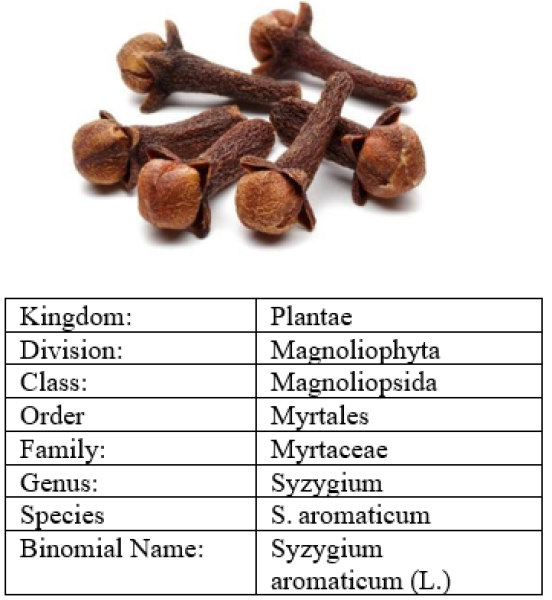
ACTIVE CONSTITUENTS AND THEIR PHARMACOLOGICAL ACTIVITIES:
- Eugenol:
Eugenol is the primary active compound in cloves, constituting about 70-90% of the essential oil extracted from the buds. It possesses several pharmacological activities, including analgesic (pain-relieving), anti-inflammatory, and antimicrobial properties. Eugenol is also known for its local anaesthetic effects and can be used topically for toothaches and oral pain.
2. Caryophyllene:
Caryophyllene is a sesquiterpene compound found in cloves and other plants. It has anti-inflammatory properties and acts as a selective agonist of cannabinoid receptor type 2 (CB2), which is involved in modulating the immune response and reducing inflammation.
3. Acetyl eugenol:
Acetyl eugenol is a derivative of eugenol found in cloves. It exhibits antioxidant and anti-inflammatory properties. It has been studied for its potential protective effects against oxidative stress and inflammation-related conditions.
4. Beta-caryophyllene:
Beta-caryophyllene is a bicyclic sesquiterpene found in cloves. It is known for its anti-inflammatory and analgesic properties. Beta-caryophyllene selectively activates the CB2 receptor and exhibits potential therapeutic effects in various inflammatory conditions.
5. Tannins:
Cloves contain tannins, which are polyphenolic compounds with astringent properties. Tannins can help alleviate diarrhoea and have antimicrobial effects. They may also have antioxidant properties and contribute to the overall medicinal benefits of cloves.
6. Flavonoids:
Cloves contain various flavonoids, including kaempferol, rhamnetin, and quercetin. These compounds possess antioxidant and anti-inflammatory properties and may contribute to the overall health benefits of cloves.
IDENTIFICATION TEST
Appearance: Clear, yellow liquid, which becomes brown when exposed to air. Solubility: Miscible with methylene chloride with toluene and with fatty oils.
Chemical test:

A drop of clove oil is dissolved in 5ml alcohol and a drop of ferric chloride solution is added; due to the phenolic OH group of eugenols, a blue colour is seen.
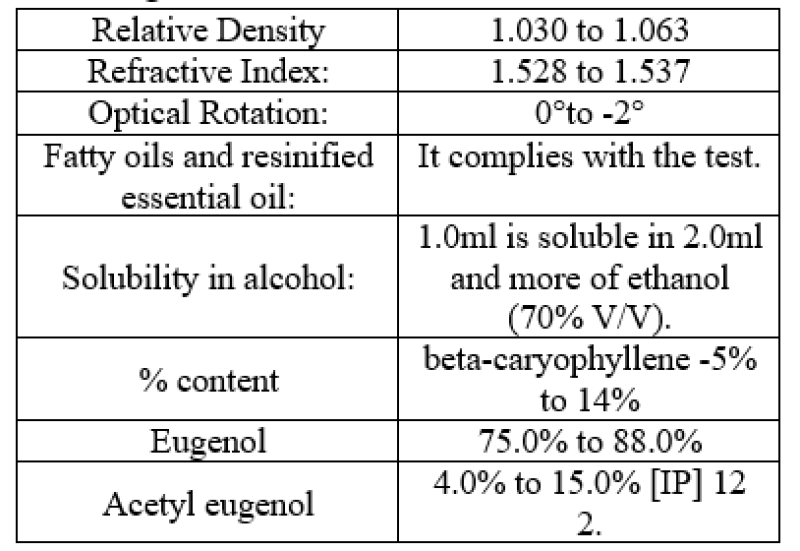
CINNAMON:
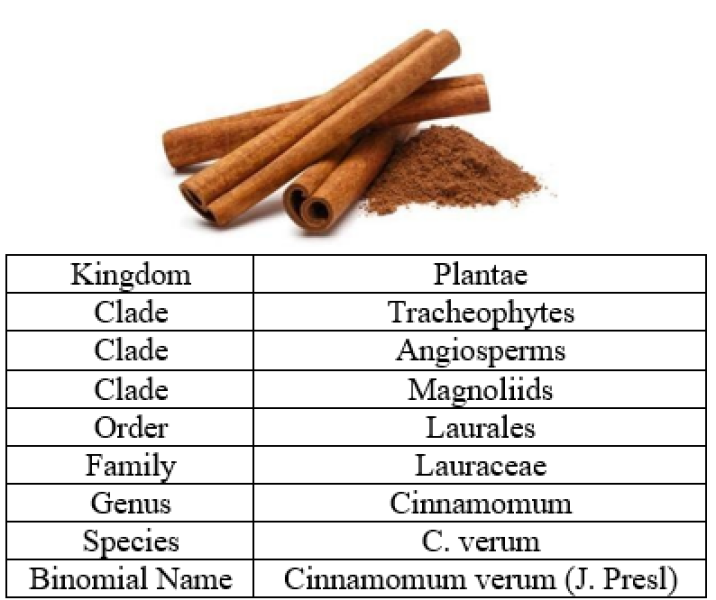
ACTIVE CONSTITUENTS AND THEIR PHARMACOLOGICAL ACTIVITIES:
- Cinnamaldehyde:
This is the main active compound responsible for the characteristic flavour and aroma of cinnamon. It possesses antioxidant, anti-inflammatory, and antimicrobial properties.
2. Eugenol:
Found in varying amounts in different types of cinnamon, eugenol contributes to the spicy and sweet aroma of the spice. It also has antioxidant and antimicrobial properties.
3. Coumarin:
This compound is present in higher amounts in Cassia cinnamon (Cinnamomum cassia) compared to Ceylon cinnamon (Cinnamomum verum or Cinnamomum zeylanicum). Coumarin is responsible for the sweet aroma of cinnamon but may have adverse effects in high doses. 13
4. Cinnamic acid:
Cinnamon contains cinnamic acid and its derivatives, such as caffeic acid and ferulic acid. These compounds possess antioxidant properties and contribute to the overall health benefits associated with cinnamon consumption.
5. Procyanidins:
Cinnamon contains oligomeric procyanidins, which are a type of flavonoid compound with antioxidant and anti-inflammatory properties. These compounds may contribute to the potential health benefits of cinnamon. In addition to these major constituents, cinnamon also contains trace amounts of essential oils, vitamins, minerals, and other beneficial compounds.
IDENTIFICATION TEST:
Content: minimum 12mg/kg of essential oil. Characters: characteristic aromatic odour Chemical test
- A drop of volatile oil is dissolve in 5ml of alcohol and to it a drop of ferric chloride is added. A pale green colour is produced. (Cinnamic aldehyde gives brown colour with ferric chloride, whereas eugenol gives blue colour.)
3. BEES WAX:
Beeswax is a tough wax formed from a mixture of several compounds. Beeswax has a relatively low melting point range of 62 to 64 °C (144 to 147 °F).
Category:
Pharmaceutical aid (stiffening agent)
Description:
Beeswax is a fragrant solid at room temperature. The colours are light yellow, medium yellow, or dark brown and white. If beeswax is heated above 85 °C (185 °F) discoloration occurs. The flash point of beeswax is 204.4 °C (400 °F).[16]
4.PARAFFIN OIL:
White mineral oil; liquid petrolatum.
Liquid paraffin is a purified mixture of liquid hydrocarbons obtained from petroleum to which not more than 10ppm tocopherol or of butylated hydroxytoluene may be added.
Category:
laxative; Lubricant.
Description:
a transparent, colourless, oily liquid, free from fluorescence by daylight; odourless or almost odourless. [IP]
- BORAX:
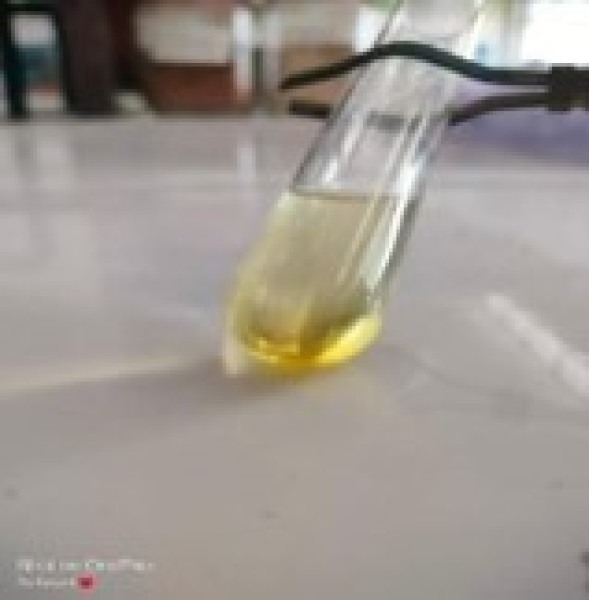
Borax or sodium borate.
Molecular wt. 381.4 g/mol; chemical formula: Na2B4O7-10H2O
Definition:
borax contains not less than 99.0% and not more than the equivalent of 103.0% of disodium tetraborate decahydrate.
Description:
A white, crystalline powder, colourless crystal or crystalline masses, efflorescent, soluble in water, very soluble in boiling water, freely soluble in glycerol. [IP]
- PROPYL PARABEN:
Propyl paraben is propyl 4-hydroxybenzoate.
Chemical formula:
C10H12O3; Mol. Wt. 180.2 g/mol.
Propyl paraben contain not less than 98.0% and not more than 102.0% of C10H12O3, calculated on the dried basis.
Category:
Pharmaceutical aid (antimicrobial preservative)
Description:
a white crystalline powder; odourless.
Table 1: - Formulation of Cream base
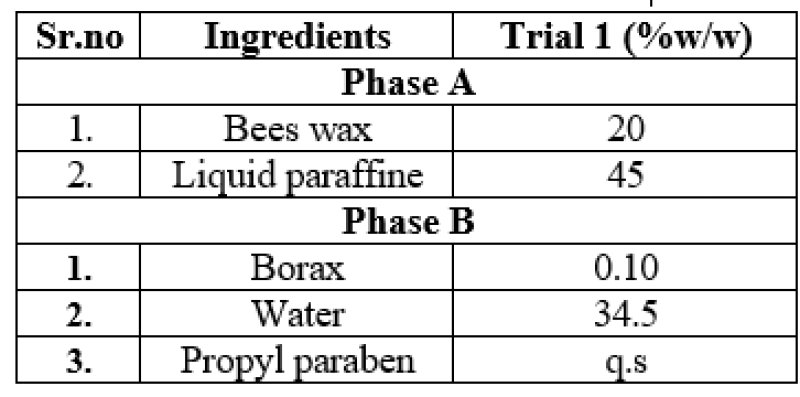
Procedure:
- All the ingredients of phase A and phase B were taken in separate porcelain dishes.
- Bees wax of oil phase (Phase A) are taken first for melting and then liquid paraffin will be added in order of increasing melting point and heat oil phase up to 75°C in a porcelain dish on water bath.
- Ingredients of aqueous phase (Phase B) are mixed in predetermined proportion and heated to the same temperature as of oil phase (75°C.)
- At 75°C, add aqueous phase in oil phase slowly.
- All the ingredients are mixed with continuous stirring until a smooth and stable emulsion is formed.
- Then the cream was allowed to cool down to the room temperature and transferred to suitable container. Since, formulation Trial II (C-1) gave a satisfactory product as a cream base; it was selected as a suitable cream base for incorporation of clove oil and cinnamon oil.
- Two different concentrations of both oils (i.e., 0.5% and 1%) were incorporated in cream base to formulate two formulations of antimicrobial cream (F1, F2) respectively
Table 2: - Formulation of cream containing clove oil and cinnamon oil

Evaluation parameter of cream:
1. Determination of pH: The pH of the formulated cream was measured by using pH paper at room temperature. It was found to be in range of 6-7.

Figure 7: pH Determination of cream
Physical appearance:
The physical appearance of the cream was observed by its colour, roughness and graded.
F1: white with consistency and soften in nature. F2: white with consistency and soften in nature.
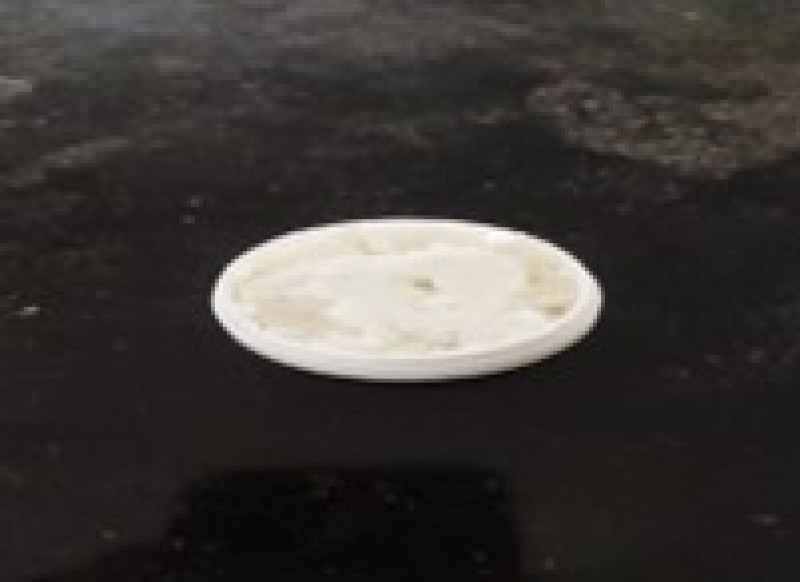
Figure 8: Physical appearance of cream
Spredability:
Adequate amount of sample is taken between two glass slides and a weight of 100gm is applied on the slides for 5 minutes. Spreadability can be expressed as, S= m*l/t
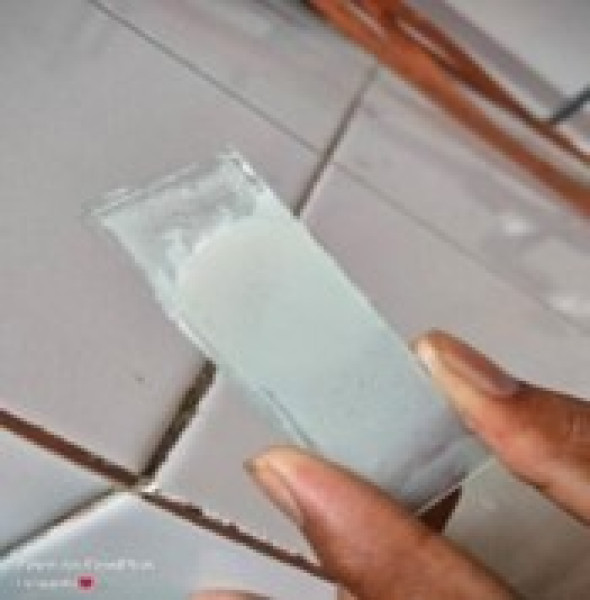
Figure 9: Spreadability test
- Homogeneity:
The formulation was tested for the homogeneity by visual appearance and by touch.
- Removal:
The ease of removal of the creams applied was examined by washing the applied part with tap water.
- Irritancy study:
Mark an area of 1sq.cm on the left-hand dorsal surface. The cream was applied to the specified area and time was noted. Irritancy, erythema, edema was checked.
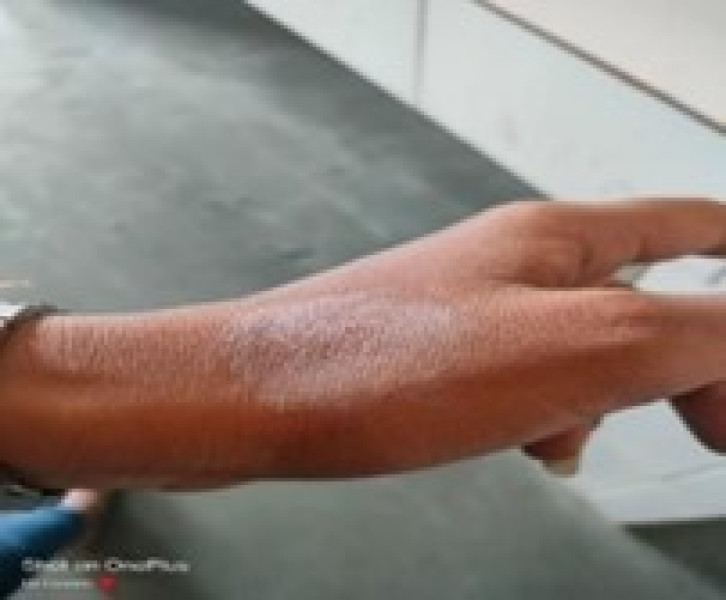
Figure 10: Skin Irritation Test
RESULT AND DISCUSSION:
The antimicrobial cream was observed by changes in parameters like colour, odour, pH, viscosity and particle size under normal conditions and antimicrobial cream was found to be substantially stable. The prepared creams (F1 and F2) were found to be homogeneous and in good appearance and consistency. The pH values of both the formulations were in the close range of (6-7). The formulation was slightly irritating to skin due to the spicy nature of clove and cinnamon. The Spreadability of formulation (F1 and F2) indicates that the cream formulation is easy to apply. The formulation (F1 and F2) was found to be more consistent.
Evaluation result of antimicrobial cream
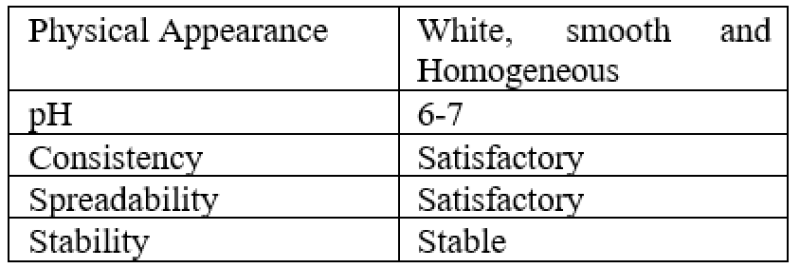
CONCLUSION:
In India there are many medicinal plants which are used from ancient times for skin care. Natural preparation is more acceptable in recent trends which are mostly recommended as having less or no side effect. The idea to be submerging this formulation was its antimicrobial property. Clove oil and cinnamon oil are both known for their antimicrobial properties. They contain bioactive compounds such as eugenol in clove oil and cinnamaldehyde in cinnamon oil, which have been shown to exhibit antibacterial, antifungal, and antiviral activities. These compounds can inhibit the growth and proliferation of various microorganisms, including bacteria and fungi. The cream shows its effect against certain skin infections, wounds, or other dermatological conditions caused by microorganisms. The antimicrobial properties of the essential oils might help in reducing the microbial load and promoting healing. This study was undertaken with aim to formulate, develop and evaluate antimicrobial cream by using two different concentrations of clove oil and cinnamon oil. From the results of the present study, it can be concluded that antimicrobial cream containing 0.3ml Clove oil and 0.3ml Cinnamon oil (F2) was acceptable in view of improvement in infectious skin condition and contains all good characters of skin cream.
REFERENCES:
- Hughes, G.R., J.Soc. Cosmet. Chem., 1959, X, 159.
- Encyclopaedia. Britannica, 14th Edn; 1929.
- Kapoor.V.P., Herbal Cosmetics for Skin and Hair Care, Natural Product Radiance, p 306-314.
- Spencer N. India Set to Reduce Restrictions on Cosmetic Imports; 2016. Available from: https://www.cosmeticsdesign-asia.com/ article/2016/09/20/India-set-toreduce-
- Bindra N. Home - NKG Advisory Business and Consulting Services Private Limited; 2020. Available from: https://www.nkgabc.com. [Last accessed on 2021 Jan 20].
- Cosmetic Regulation in India, CliniExperts; 2016. Available from: https://www.cliniexperts.com/cosmetic-regulatory-affairs. [Last accessed on 2020 Oct 05].
- Srikanth, Syed sajjad Hussen, Anand Abha, Vasantharaju & Sandeep Gummudavelly A comparative view on cosmetic regulations: USA, EU and INDIA. Der Pharmacia Lettre, 2011, 3(1): 334-341
- Hendriks, F. M., Brokken, D., Oomens, C. W. J., Baaijens, F. P. T., & Horsten, J. B. A. M. (2000). Mechanical properties of different layers of human skin. Internal Poster (http://yp. bmt. tue. nl/pdfs/249. pdf), Department of Biomedical Engineering, Eindhoven University of Technology.
- Honari, G. (2017). Skin structure and function. In Sensitive Skin Syndrome (pp. 16-22). CRC Press.
- Benson, H. A. (2012). Skin structure, function, and permeation. Topical and transdermal drug delivery: Principles and practice, 1-22.
- Esther Boelsma and others, Nutritional skin care: health effects of micronutrients and fatty acids, The American Journal of Clinical Nutrition, Volume 73, Issue 5, May 2001, Pages 853– 864, https://doi.org/10.1093/ajcn/73.5.853.
- Katarina Chiller, Bryan A. Selkin, George J. Murakawa, Skin Microflora and Bacterial Infections of the Skin, Journal of Investigative Dermatology Symposium Proceedings, Volume6, Issue 3,2001, Pages 170- 174, ISSN 1087-0024, https://doi.org/10.1046/j.0022202x.2001.00043.x.(https://www.sciencedirect.com/science/arti cle/pii/S0022202X15529011).
- Aly R. Microbial Infections of Skin and Nails. In: Medical Microbiology. 4th edition. University of Texas Medical Branch at Galveston, Galveston (TX); 1996. Available from https://www.ncbi.nlm.nih.gov/books/NBK8301 PMID: 21413322.
- Hay R. J. (1992). Fungal skin infections. Archives of disease in childhood, 67(9), 1065– 1067. https://doi.org/10.1136/adc.67.9.1065.
- Sahu T, Patel T, Sahu S, Gidwani B, “Skin Cream as Topical Drug Delivery System: A Review” Journal of Pharmaceutical and Biological Sciences, Published by Atom and Cell Publishers, ISSN: 2320-1924.
- Kumar Sampath k.p, Bhomik Debjit etal industrial pharmacy "Nirali Prakashan" first edition 2020 June : 1.1-1.23.
- Research, Center for Drug Evaluation and (3 November 2018). "Compounding and the FDA Questions and Answers". FDA. Archived from the original on 17 December 2019. 18.
- Retrieved 16 December 2019. Vyas S. P, khar k.roop etal industrial pharmacy "Lechman Liebermans" fourth edition2020 : 36-40.
- Mudagal P.Manjunatha, Sharma Raj Uday etal pharmacology ll "Nirali Prakashan" first edition 2019 Sep: 1.1-1.5. Mehata R.M etal pharmaceutics “Vallabh Prakashan" 6th edition 2019 : 1-100.
- Tripathi.K.D etal essential of medical pharmacology "K.D Tripathi" 6th edition 2003 : 1- 78.
- Hajare A . Ashok etal Pharmaceutics " Nirali Prakashan" 1st edition 2021-oct : 1-90
- Bramhankar.M.D , Jaiswal B. Sunil etal Biopharmaceutics and pharmacokinetics "vallabh Prakashan" 2nd edition 2009 : 20-40.
- Chauhan, L., & Gupta, S. (2020). Creams: A Review on Classification, Preparation Methods, Evaluation and its Applications. Journal of Drug Delivery and Therapeutics, 10(5-s), 281-289. https://doi.org/10.22270/jddt.v10i5-s.4430.
- K.S. Misar, S.B. Kulkarni, W.B. Gurnule, Formulation and evaluation of antiacne cream by using Clove oil, Volume 29, Part 4,2020, Pages 1251-1258, ISSN 2214-7853, https://doi.org/10.1016/j.matpr.2020.06.106.
- Sha ‘at, F.; Pavaloiu, R.-D.; Hlevca, C.; Staras, A.; Rasit, I.; Mati, E.; Voicu, M.; Serban, R.; Pirvu, L. Formulation and Evaluation of an Antimicrobial Cream Containing Cinnamon Oil for Topical Application. Proceedings 2020, 57, 17. https://doi.org/10.3390/proceedings2020057017.
- Hashemi, S. M. B., & Khodaei, D. (2020). Antimicrobial activity of Satureja Khuzestanica Jamzad and Satureja bachtiarica Bunge essential oils against Shigella flexneri and Escherichia coli in table cream containing Lactobacillus plantarum LU5. Food Science & Nutrition, 8(11), 5907-5915.
- https://media.istockphoto.com/id/1089394678/photo/dried-clove-buds-isolated-on-
- whitebackground.jpg?s=612x612&w=0&k=20&c=mVAM9LLewiOz6VIau0XltghuFl3_K4JItCUvnSfdGk=https://media.istockphoto.com/id/1134101282/photo/cinnamon-sticks- onwhite.jpg?s=612x612&w=0&k=20&c=kRJ8H48luI4NQv4tjHup3MQyjVUI6vezCioODI_M kCM= 25
- Indian Pharmacopoeia, Government of India, Ministry of Health & Family Welfare, The Indian Pharmacopoeia Commission; Vol. I, 6th ed., 2010,
- https://en.wikipedia.org/wiki/Beeswax 17. Wong Y. C, Ahmad-Mudzaqqir M. Y, Wan-Nurdiyana W.A. Extraction of Essential Oil from Cinnamon (Cinnamomum Zeylanicum). Orient J Chem 2014;30(1)
- Practical pharmaceutical microbiology by Prof. Md. Usman, Kiran D,1st edition, S Vikas company 1st edition, 2018.
- Practical pharmaceutical microbiology by Dr. Imtiyaz Wani, PV Publications. 1st edition, pg.no 34 to 41.
- Chen, M. X., Alexander, K. S., & Baki, G. (2016). Formulation and evaluation of antibacterial creams and gels containing metal ions for topical application. Journal of pharmaceutics, 2016.


 Shinde Avinash B.*
Shinde Avinash B.*
 Tagare Chetan B.
Tagare Chetan B.












 10.5281/zenodo.10794548
10.5281/zenodo.10794548